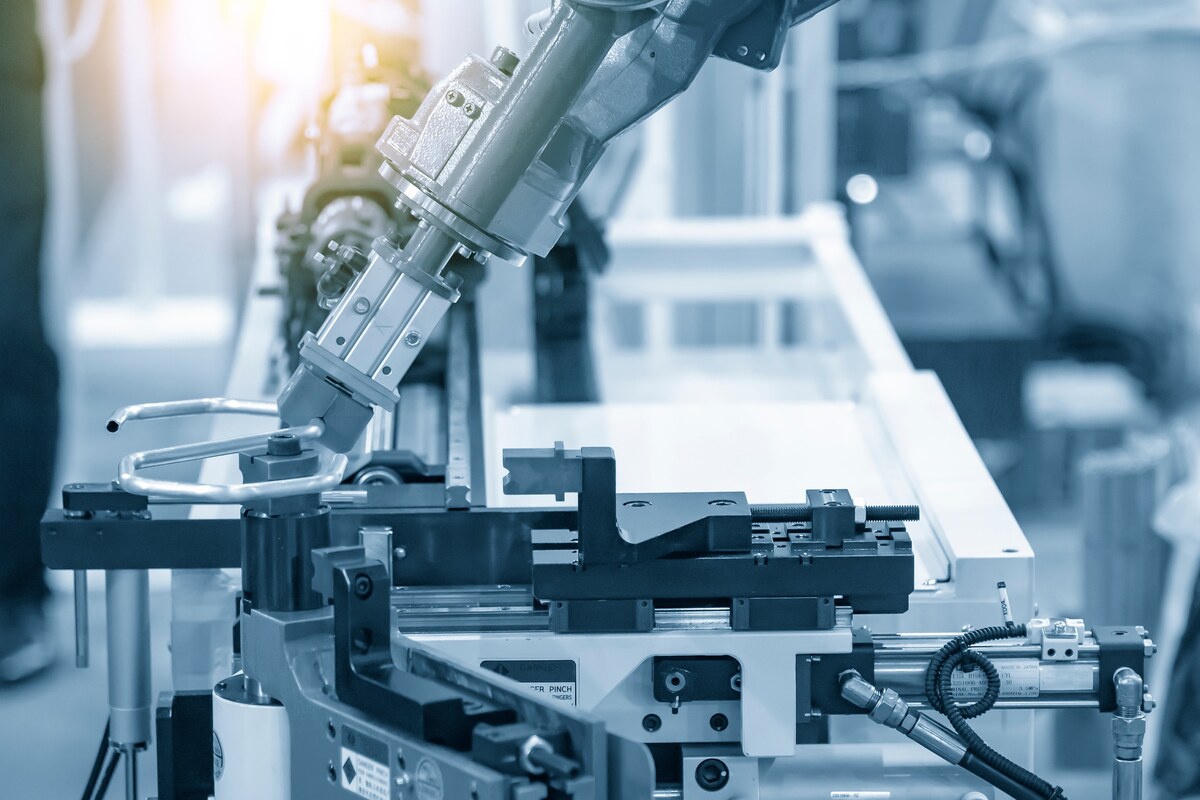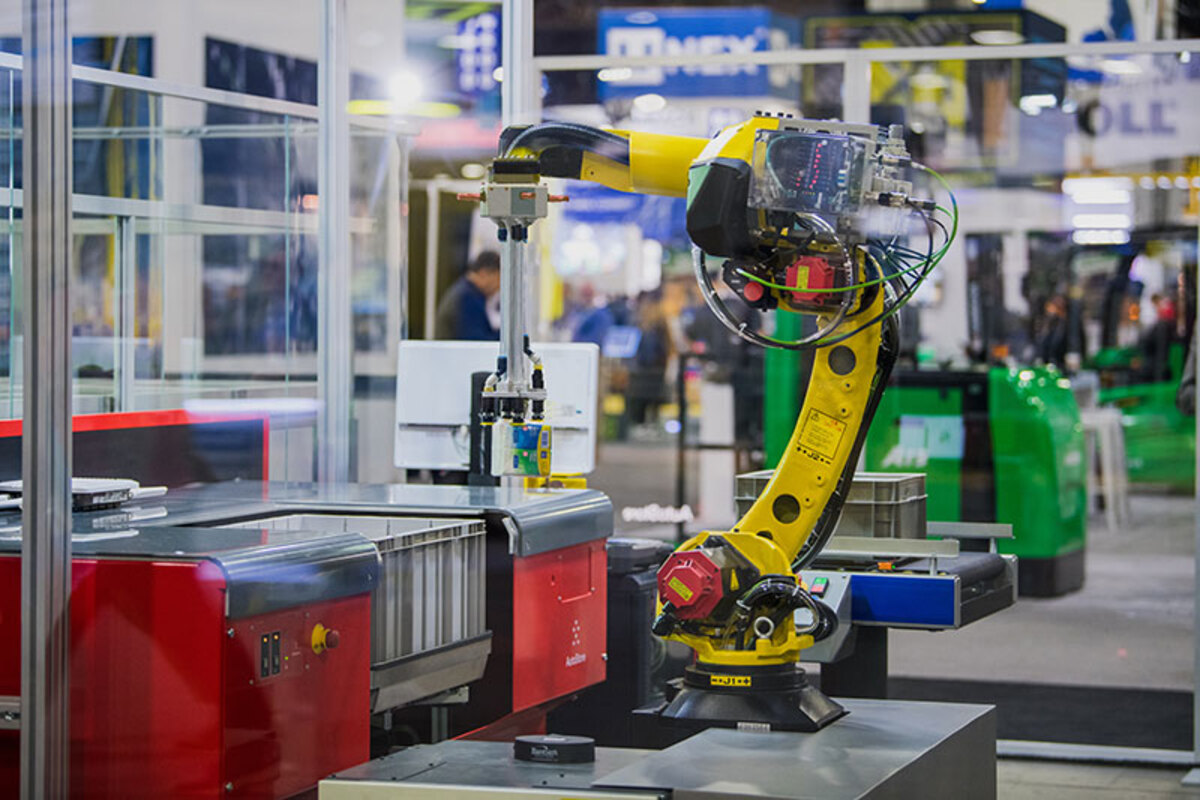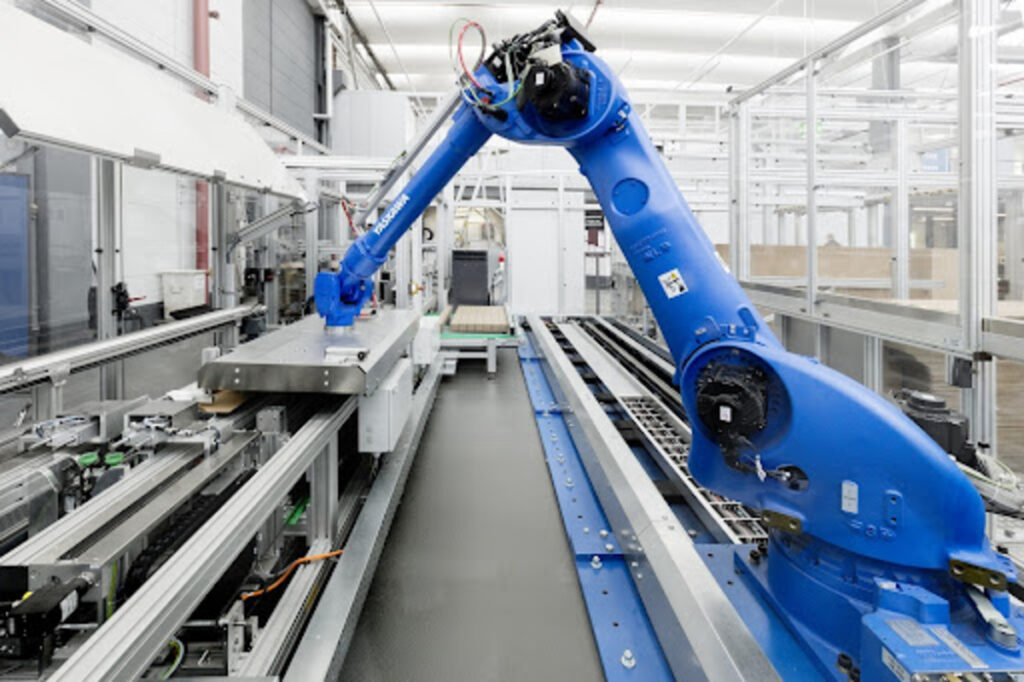Robotics is revolutionizing the handling of materials and goods in the manufacturing and industrial sectors because of constantly evolving technical breakthroughs. It makes it reasonable that there would be a wide range of robot solutions available for material handling given the scope of the work.
Robotic material handling and tending solutions increase productivity significantly both in principle and in practice. Recently, production constraints for pinion gear drive train components were being experienced by an agricultural producer. To replace manual loading and unloading for the lathe and part cleaning processes, they required an automation solution.
The company achieved significant uptime and cycle time reductions, with 16 different parts having a cycle time of less than 60 seconds each, by designing and implementing a robotic material handling and tending system. The robotic system for material handling and tending has a revolutionary effect on their business processes.
For manufacturers, robotic tending systems and material handling offer numerous advantages. As demonstrated in the previous example, they can be effectively designed and applied to eliminate expensive manufacturing pain points. But there’s more to the tale when you consider the agricultural manufacturer’s remarkable cycle times and uptime.
Table of Contents
What is Robotic Material Handling?
The employment of robots to move and transport items during a production process is known as robotic material handling. This can be used in many different ways, and contemporary robots are capable of handling differences in the size, weight, and texture of objects, carrying out tasks that previous robotic systems were unable to.
These robots, depending on the type, are usually fitted with a range of sensors that allow them to safely and effectively detect and interact with their surroundings. This makes it possible for them to be effectively and smoothly incorporated into the current manufacturing processes, facilitating the flow of materials.
Various forms of industrial automation exist, including:
- A system or procedure that is intended to carry out a certain task consistently without requiring human intervention or modification is known as fixed automation.
- The capacity to program devices or systems to carry out particular duties or processes automatically is known as programmable automation. Compared to stationary machinery, this offers greater flexibility, making it perfect for batch production.
- Systems and technologies that are quick to adapt to modifications in the needs and procedures of production.
- Integrated automation encourages customization and flexibility by uniting machines and devices under a single control system.
Whichever kind you’re employing, robotic material handling has transformed the industrial sector by allowing for minimal downtime and continuous operation. These methods not only increase output but also aid in the effective management of rising consumer demand and labor shortages.
Suggested articles to read: Top 7 Robotic Welding and Fabrication Types in Construction (2024)

How do Robotic Material Handling Machines Work?
Robotic material handling devices can identify and analyze various features of the items they are handling because of their sophisticated programming and usage of sensors to carry out operations efficiently.
There are several things to consider while choosing which robot to use. The best location for the robots and the kind and quantity of robots needed are determined by the layout of the facility. The design and capabilities of the robots are influenced by the kind of material being handled, including dangerous, bulky, and fragile materials. To guarantee effective and secure robotic material handling operations, payload, and speed requirements must also be taken into account.
Suggested article to read: Bricklaying Robots in Construction Automation; 2024 Guide
The Benefits of Robotic Material Handling
There are several advantages to robotic material handling equipment that have the potential to completely transform how jobs are done. The following are some benefits of utilizing these devices:
- Enhanced Productivity: Robotic material handling equipment can work continuously without rest periods or weariness, which can lead to a notable boost in productivity. They enable more effective operations by handling repeated activities with speed and accuracy.
- Enhanced Safety: These technologies reduce the danger of damage by eliminating the repetitive nature of manual material handling. The load and unload procedures are automated to safeguard employees from possible risks.
- Enhanced Accuracy: Robotic material handling robots can handle materials with greater accuracy thanks to the application of cutting-edge technology, which reduces errors and raises the caliber of the final product.
- Savings: Over time, firms will save a lot of money by cutting labor expenditures and doing away with idle time brought on by accidents or exhaustion.
All things considered, there are several advantages to integrating robotic material handling equipment into industrial operations that improve productivity, security, and profitability.
Suggested article to read: The Role of 3D Printing Robots in Construction; 2024 Guide
How Robotic Material Handling Tasks
When done by hand, material handling can be a boring and monotonous activity. Sadly, this may result in employees who aren’t happy or invested in their work, which lowers morale and performance. It is not surprising that material handling jobs are among the most frequently automated manufacturing applications, as operations of this nature are frequently excellent candidates for automation. In fact, for producers who are new to robotics, this category of tasks is typically the first to be automated.
1. Part Presentation
Robotic material handling can be presented with parts via processes in several ways. Belt conveyors are a popular way to present parts. This is particularly true when parts are moved over long distances between stations. Nonetheless, alternative approaches to portion presentation are frequently observed, including:
- Additional robots
- Turntables
- Table loading
- Other devices
- Systems of Kanban
Suggested article to read: What is Robotic Material Handling? 2024 Guide
2. Part Location
Applications for material handling use the robot’s capacity to carry out repetitive operations rapidly and effectively over a prolonged period of time. The cycles of robotic material handling operations are often predictable, with pieces arriving in the same orientation and location each time. Extra sensors or visual systems can help the robot locate items in uncertain jobs.
3. A portion of Manipulation
Robots use specialized end-of-arm tools to manipulate items. For effective and reliable control, these instruments have been selected with the particular aim in mind. For the majority of applications, integrators frequently select mechanical grippers. Nonetheless, an electromagnetic gripper can be useful for ferrous materials. A suction cup or soft gripper can be needed for additional components. The ideal gripper type is frequently determined by the type of part.
Every automation application requires application details. But in applications involving material handling, they are particularly important. Neglecting particular needs can result in a system that performs poorly or is unable to do the intended task. For instance, a robot that is unable to consistently handle the component may be the consequence of a bad gripper selection. While it’s important to understand these details, most manufacturers benefit from working with automation experts.

What is the Role of Robotics in Material Handling?
A significant part of the automation of many material-handling jobs is the use of robots. Automation is transforming the material handling sector with its ability to grasp, move, and position objects as well as create integrated mobile robotic platforms.
A handling robot used to be a robotic arm fixed permanently in a certain location, like an assembly line, to connect different pieces. But thanks to recent developments, there are now robots with arms that are integrated into self-sufficient mobile robotic platforms, which allow them to move and carry out a variety of handling jobs whenever and wherever they are needed.
Your choice of machine type will determine its capabilities. The following are just a few typical uses for robotic material handling:
1. In-person Selection and Packaging of Goods
Robotic material handling uses cutting-edge technology to expedite the production of goods. These robots can recognize and grab things of different sizes and forms thanks to their advanced sensing systems. Through the reduction of physical labor, this method promotes efficiency and saves time.
2. Transfer of Parts
With the use of sophisticated end-of-arm tooling and vision systems, part transfer robots are made expressly to handle large, heavy components and accurately pick them up and move them from one place to another. This lowers labor expenses and lowers the possibility of human error, which prevents production line delays.
3. Conveyors for loading
Efficient and speedy loading of goods into a moving monorail conveyor system is made feasible by robots. Robotic material handlings can pick up containers and deposit them on the conveyor by using suction tools, such as vacuum-gripping end effectors. This not only boosts productivity but also lowers the possibility of product damage and enhances worker safety by preventing any unintentional spills or drops during transit.
Suggested article to read: Robotic Excavators and Diggers in Construction Automation
4. Managing (Dangerous Substances)
Robots can handle dangerous materials in harsh conditions with safety and speed. They are vital for jobs like removing dangerous chemicals, tapping molten slag from furnaces, moving objects that need particular handling, and gathering data over extended periods in challenging environments. They are shielded by heat-resistant armor.
Robotic material handling is perfect for challenging material handling activities since it can withstand even the harshest temperatures and chemical compositions. When using human labor is too risky or impractical, they offer a reliable substitute.
5. Palletising and Depalletising
Based on preset parameters, robots can be programmed to accurately stack items in orderly rows on a pallet. Additionally, they can swiftly and precisely filter through mixed pallets without running the risk of coming into contact with hazardous goods.
On the other hand, using specialized grippers made for specific shapes and sizes of commodities, robots may carefully extract (and depalletize) articles from stacked mounds of material.
6. Classifying
Manual sorting can be laborious, error-prone, and ineffective. Businesses can save time and effort by automating this tedious operation using robots. Items like mail, clothes, food, and other things can be programmed to be sorted based on certain criteria or categories.
Suggested article to read: What are Demolition Robots in Construction? 2024 Guide
Trends and Innovations in Robotic Material Handling
Recent developments in robotic technology are revolutionizing the applications of robotics beyond what we have already covered.
These developments have a tight connection to:
- Automated Guided Vehicles (AGV): Robotic material handling systems that move around warehouses on their own, without the need for a driver or operator. They use magnetic tapes or wires to follow predetermined routes.
- Autonomous Mobile Robots (AMR): These are mobile robots that can navigate their surroundings on their own without following a preset route. They can therefore adapt to unforeseen challenges.
New developments in these technologies are altering how businesses handle material handling tasks.
1. Machine Learning
Robotic material handling can adapt, optimize routes, and boost efficiency because AI and machine learning algorithms are always learning from real-time data. Thanks to these technologies, material handling has undergone a revolution since robots are now capable of autonomous decision-making and data analysis.
AGVs can continuously enhance their performance by using machine learning to find trends in the data they gather. As a result, they may optimize their energy use, cutting expenses and minimizing their negative effects on the environment.
Moreover, machine learning makes it possible for AGVs to precisely forecast maintenance requirements. They can plan maintenance tasks proactively, avert expensive breakdowns, and guarantee continuous operations by seeing wear indicators or possible faults early on.
2. Cutting Edge Sensors
Advanced sensors help autonomous cars and robots detect objects more accurately, avoid obstacles, and navigate through busy places more effectively. Examples of these sensors include LiDAR, vision systems, and proximity sensors. These cutting-edge sensor technologies offer unparalleled navigation precision, improved obstacle avoidance capabilities, and higher object detection accuracy. They also provide better safety measures for dynamic environments and more effective sorting processes.
Robots are now more capable than ever of operating securely and precisely, thanks to technical improvements, which makes them indispensable instruments in the material handling sector.

3. Cooperative Robots for Material Processing
Collaborative robots provide enhanced safety features for dynamic situations and facilitate accurate and efficient material handling activities. Because these robots are made to operate alongside people, the workforce will be more productive.
This enables producers to increase output and improve the quality of goods produced while lowering labor expenses related to physical labor. Because they may be programmed to do specific tasks, they can swiftly adjust to changes in the environment or production process.
Conclusion
In the industrial sector, robotic tending systems and material handling are standard. Robotic arms that move production parts—typically on or off a conveyor belt or to hold a part in place for manufacture—are referred to as material handling. Similar but more focused, machine tending describes the use of a robotic arm to load and unload a stationary industrial machine.
Robotic material handling is used in nearly every sector. Material handling robots are so widely used in manufacturing that it is difficult to find an industry that does not use them. Machine tending systems and robotic material handling are in great demand because they consistently increase productivity across a variety of applications.
These systems’ significantly higher uptime accounts for a large portion of their advantages. Handling and tending materials by hand is inefficient, erratic, and slow. Robots are highly consistent and can operate nonstop, except for brief maintenance intervals.
Not only do robots have higher uptime, but they also tend to be speedier than manual procedures. Productivity is positively impacted when a production part’s cycle time is reduced. Shorter cycle times have cumulative benefits that are very significant to manufacturers.
Robotic material handling uses cutting-edge technology to transport products or parts to the desired location at the desired time. Robotic material handling searches for ways to incorporate robotics or other technologies into your system, line, or facility while making sure that the integration is ergonomic, safe, and effective.
Suggested article for reading:
Smart Building Technology; 2024 Guide
Futuristic Construction; Everything You need to know in 2024
Resources:
LenochEngineering | Genesis-Systems | HowtoRobot | Robotnik | JrAutomation | Berkshiregrey | Robodk | KawasakiRobotics
For all the pictures: Freepik



